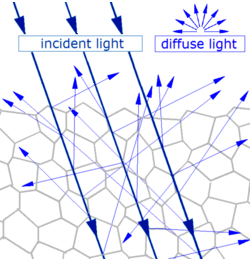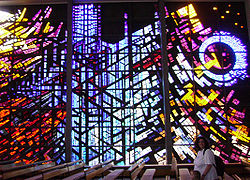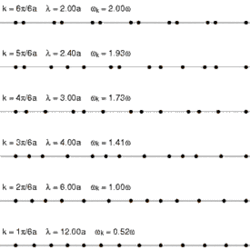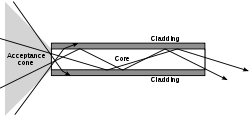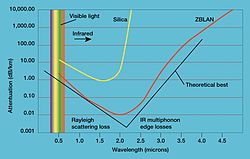- Transparency and translucency
-
"Diaphanes" redirects here. For the genus of firefly, see Diaphanes (beetle)."Translucence" redirects here. For other uses, see Translucence (disambiguation)."Translucent" redirects here. For the Japanese manga series, see Translucent (manga).
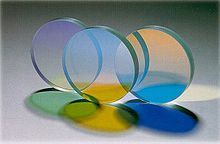 Dichroic filters are created using optically transparent materials.
Dichroic filters are created using optically transparent materials.
In the field of optics, transparency (also called pellucidity or diaphaneity) is the physical property of allowing light to pass through a material; translucency (also called translucence or translucidity) only allows light to pass through diffusely. The opposite property is opacity. Transparent materials appear clear, with the overall appearance of one color, or any combination leading up to a brilliant spectrum of every color. When light encounters a material, it can interact with it in several different ways. These interactions depend on the wavelength of the light and the nature of the material. Light waves interact with an object by some combination of reflection, and transmittance with refraction.
Some materials, such as plate glass and clean water, allow much of the light that falls on them to be transmitted, with little being reflected; such materials are called optically transparent. Many liquids and aqueous solutions are highly transparent. Absence of structural defects (voids, cracks, etc.) and molecular structure of most liquids are mostly responsible for excellent optical transmission.
Materials which do not allow the transmission of light are called opaque. Many such substances have a chemical composition which includes what are referred to as absorption centers. Many substances are selective in their absorption of white light frequencies. They absorb certain portions of the visible spectrum, while reflecting others. The frequencies of the spectrum which are not absorbed are either reflected back or transmitted for our physical observation. This is what gives rise to color. The attenuation of light of all frequencies and wavelengths is due to the combined mechanisms of absorption and scattering.[1]
 Simulated comparisons of (from top to bottom): decreasing levels of opacity; increasing levels of translucency; and increasing levels of transparency; behind each panel is a left-right gradiented grey star
Simulated comparisons of (from top to bottom): decreasing levels of opacity; increasing levels of translucency; and increasing levels of transparency; behind each panel is a left-right gradiented grey star
Contents
Introduction
With regard to the absorption of light, primary material considerations include:
- At the electronic level, absorption in the ultraviolet and visible (UV-Vis) portions of the spectrum depends on whether the electron orbitals are spaced (or "quantized") such that they can absorb a quantum of light (or photon) of a specific frequency, and does not violate selection rules. For example, in most glasses, electrons have no available energy levels above them in range of that associated with visible light, or if they do, they violate selection rules, meaning there is no appreciable absorption in pure (undoped) glasses, making them ideal transparent materials for windows in buildings.
- At the atomic or molecular level, physical absorption in the infrared portion of the spectrum depends on the frequencies of atomic or molecular vibrations or chemical bonds, and on selection rules. Nitrogen and oxygen are not greenhouse gases because the absorption is forbidden by the lack of a molecular dipole moment.
With regard to the scattering of light, the most critical factor is the length scale of any or all of these structural features relative to the wavelength of the light being scattered. Primary material considerations include:
- Crystalline structure: whether or not the atoms or molecules exhibit the long-range order evidenced in crystalline solids.
- Glassy structure: scattering centers include fluctuations in density or composition.
- Microstructure: scattering centers include internal surfaces such as grain boundaries, crystallographic defects and microscopic pores.
- Organic materials: scattering centers include fiber and cell structures and boundaries.
Light scattering in solids
Main article: Light scatteringDiffuse reflection - Generally, when light strikes the surface of a (non-metallic and non-glassy) solid material, it bounces off in all directions due to multiple reflections by the microscopic irregularities inside the material (e.g., the grain boundaries of a polycrystalline material, or the cell or fiber boundaries of an organic material), and by its surface, if it is rough. Diffuse reflection is typically characterized by omni-directional reflection angles. Most of the objects visible to the naked eye are identified via diffuse reflection. Another term commonly used for this type of reflection is “light scattering”. Light scattering from the surfaces of objects is our primary mechanism of physical observation.[2][3]
Light scattering in liquids and solids depends on the wavelength of the light being scattered. Limits to spatial scales of visibility (using white light) therefore arise, depending on the frequency of the light wave and the physical dimension (or spatial scale) of the scattering center. Visible light has a wavelength scale on the order of a half a micrometer (one millionth of a meter). Scattering centers (or particles) as small as one micrometer have been observed directly in the light microscope (e.g., Brownian motion).[4][5]
Applications
See also: Transparent ceramics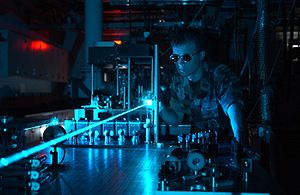 Large laser elements made from transparent ceramics can be produced at a relatively low cost. These components are free of internal stress or intrinsic birefringence, and allow relatively large doping levels or optimized custom-designed doping profiles. This makes ceramic laser elements particularly important for high-energy lasers.
Large laser elements made from transparent ceramics can be produced at a relatively low cost. These components are free of internal stress or intrinsic birefringence, and allow relatively large doping levels or optimized custom-designed doping profiles. This makes ceramic laser elements particularly important for high-energy lasers.
Optical transparency in polycrystalline materials is limited by the amount of light which is scattered by their microstructural features. Light scattering depends on the wavelength of the light. Limits to spatial scales of visibility (using white light) therefore arise, depending on the frequency of the light wave and the physical dimension of the scattering center. For example, since visible light has a wavelength scale on the order of a micrometer, scattering centers will have dimensions on a similar spatial scale. Primary scattering centers in polycrystalline materials include microstructural defects such as pores and grain boundaries. In addition to pores, most of the interfaces in a typical metal or ceramic object are in the form of grain boundaries which separate tiny regions of crystalline order. When the size of the scattering center (or grain boundary) is reduced below the size of the wavelength of the light being scattered, the scattering no longer occurs to any significant extent.
In the formation of polycrystalline materials (metals and ceramics) the size of the crystalline grains is determined largely by the size of the crystalline particles present in the raw material during formation (or pressing) of the object. Moreover, the size of the grain boundaries scales directly with particle size. Thus a reduction of the original particle size well below the wavelength of visible light (about 1/15 of the light wavelength or roughly 600/15 = 40 nm) eliminates much of light scattering, resulting in a translucent or even transparent material.
Computer modeling of light transmission through translucent ceramic alumina has shown that microscopic pores trapped near grain boundaries act as primary scattering centers. The volume fraction of porosity had to be reduced below 1% for high-quality optical transmission (99.99 percent of theoretical density). This goal has been readily accomplished and amply demonstrated in laboratories and research facilities worldwide using the emerging chemical processing methods encompassed by the methods of sol-gel chemistry and nanotechnology.[6]
Transparent ceramics have created interest in their applications for high energy lasers, transparent armor windows, nose cones for heat seeking missiles, radiation detectors for non-destructive testing, high energy physics, space exploration, security and medical imaging applications.
The development of transparent panel products will have other potential advanced applications including high strength, impact-resistant materials that can be used for domestic windows and skylights. Perhaps more important is that walls and other applications will have improved overall strength, especially for high-shear conditions found in high seismic and wind exposures. If the expected improvements in mechanical properties bear out, the traditional limits seen on glazing areas in today's building codes could quickly become outdated if the window area actually contributes to the shear resistance of the wall.
Currently available infrared transparent materials typically exhibit a trade-off between optical performance, mechanical strength and price. For example, sapphire (crystalline alumina) is very strong, but it is expensive and lacks full transparency throughout the 3–5 micrometer mid-infrared range. Yttria is fully transparent from 3–5 micrometers, but lacks sufficient strength, hardness, and thermal shock resistance for high-performance aerospace applications. Not surprisingly, a combination of these two materials in the form of the yttrium aluminium garnet (YAG) is one of the top performers in the field.
Absorption of light in solids
When light strikes an object, it usually has not just a single frequency (or wavelength) but many. Objects have a tendency to selectively absorb, reflect or transmit light of certain frequencies. That is, one object might reflect green light while absorbing all other frequencies of visible light. Another object might selectively transmit blue light while absorbing all other frequencies of visible light. The manner in which visible light interacts with an object is dependent upon the frequency of the light, the nature of the atoms in the object, and often the nature of the electrons in the atoms of the object.
Some materials allow much of the light that falls on them to be transmitted through the material without being reflected. Materials that allow the transmission of light waves through them are called optically transparent. Chemically pure (undoped) window glass and clean river or spring water are prime examples of this.
Materials which do not allow the transmission of any light wave frequencies are called opaque. Such substances may have a chemical composition which includes what are referred to as absorption centers. Most materials are composed of materials which are selective in their absorption of light frequencies. Thus they absorb only certain portions of the visible spectrum. The frequencies of the spectrum which are not absorbed are either reflected back or transmitted for our physical observation. In the visible portion of the spectrum, this is what gives rise to color.[7][8]
Color centers are largely responsible for the appearance of specific wavelengths of visible light all around us. Moving from longer (0.7 micrometer) to shorter (0.4 micrometer) wavelengths: red, orange, yellow, green and blue (ROYGB) can all be identified by our senses in the appearance of color by the selective absorption of specific light wave frequencies (or wavelengths). Mechanisms of selective light wave absorption include:
- Electronic: Transitions in electron energy levels within the atom (e.g., pigments). These transitions are typically in the ultraviolet (UV) and/or visible portions of the spectrum.
- Vibrational: Resonance in atomic/molecular vibrational modes. These transitions are typically in the infrared portion of the spectrum.
UV-Vis: Electronic transitions
In electronic absorption, the frequency of the incoming light wave is at or near the energy levels of the electrons within the atoms which compose the substance. In this case, the electrons will absorb the energy of the light wave and increase their energy state, often moving outward from the nucleus of the atom into an outer shell or orbital.
The atoms that bind together to make the molecules of any particular substance contain a number of electrons (given by the atomic number Z in the periodic chart). Recall that all light waves are electromagnetic in origin. Thus they are affected strongly when coming into contact with negatively charged electrons in matter. When photons (individual packets of light energy) come in contact with the valence electrons of atom, one of several things can and will occur:
- An electron absorbs all of the energy of the photon and re-emits it with different color. This gives rise to luminescence, fluorescence and phosphorescence.
- An electron absorbs the energy of the photon and sends it back out the way it came in. This results in reflection or scattering.
- An electron cannot absorb the energy of the photon and the photon continues on its path. This results in transmission (provided no other absorption mechanisms are active).
- An electron selectively absorbs a portion of the photon, and the remaining frequencies are transmitted in the form of spectral color.
Most of the time, it is a combination of the above that happens to the light that hits an object. The electrons in different materials vary in the range of energy that they can absorb. Most glasses, for example, block ultraviolet (UV) light. What happens is the electrons in the glass absorb the energy of the photons in the UV range while ignoring the weaker energy of photons in the visible light spectrum.
Thus, when a material is illuminated, individual photons of light can make the valence electrons of an atom transition to a higher electronic energy level. The photon is destroyed in the process and the absorbed radiant energy is transformed to electric potential energy. Several things can happen then to the absorbed energy. as it may be re-emitted by the electron as radiant energy (in this case the overall effect is in fact a scattering of light), dissipated to the rest of the material (i.e. transformed into heat), or the electron can be freed from the atom (as in the photoelectric and Compton effects).
Infrared: Bond stretching
The primary physical mechanism for storing mechanical energy of motion in condensed matter is through heat, or thermal energy. Thermal energy manifests itself as energy of motion. Thus, heat is motion at the atomic and molecular levels. The primary mode of motion in crystalline substances is vibration. Any given atom will vibrate around some mean or average position within a crystalline structure, surrounded by its nearest neighbors. This vibration in 2-dimensions is equivalent to the oscillation of a clock’s pendulum. It swings back and forth symmetrically about some mean or average (vertical) position. Atomic and molecular vibrational frequencies may average on the order of 1012 cycles per second (hertz).
When a light wave of a given frequency strikes a material with particles having the same or (resonant) vibrational frequencies, then those particles will absorb the energy of the light wave and transform it into thermal energy of vibrational motion. Since different atoms and molecules have different natural frequencies of vibration, they will selectively absorb different frequencies (or portions of the spectrum) of infrared light. Reflection and transmission of light waves occur because the frequencies of the light waves do not match the natural resonant frequencies of vibration of the objects. When infrared light of these frequencies strikes an object, the energy is reflected or transmitted.
If the object is transparent, then the light waves are passed on to neighboring atoms through the bulk of the material and re-emitted on the opposite side of the object. Such frequencies of light waves are said to be transmitted.[9][10]
Transparency in insulators
An object may be not transparent either because it reflects the incoming light or because it absorbs the incoming light. Almost all solids reflect a part and absorb a part of the incoming light.
When light falls onto a block of metal, it encounters atoms that are tightly packed in a regular lattice and a "sea of electrons" moving randomly between the atoms.[11] In metals, most of these are non-bonding electrons (or free electrons) as opposed to the bonding electrons typically found in covalently bonded or ionically bonded non-metallic (insulating) solids. In a metallic bond, any potential bonding electrons can easily be lost by the atoms in a crystalline structure. The effect of this delocalization is simply to exaggerate the effect of the "sea of electrons". As a result of these electrons, most of the incoming light in metals is reflected back, which is why we see a shiny metal surface.
Most insulators (or dielectric materials) are held together by ionic bonds. Thus, these materials do not have free conduction electrons, and the bonding electrons reflect only a small fraction of the incident wave. The remaining frequencies (or wavelengths) are free to propagate (or be transmitted). This class of materials includes all ceramics and glasses.
If a dielectric material does not include light-absorbent additive molecules (pigments, dyes, colorants), it is usually transparent to the spectrum of visible light. Color centers (or dye molecules, or "dopants") in a dielectric absorb a portion of the incoming light wave. The remaining frequencies (or wavelengths) are free to be reflected or transmitted. This is how colored glass is produced.
Most liquids and aqueous solutions are highly transparent. For example, water, cooking oil, rubbing alcohol, air, natural gas, are all clear. Absence of structural defects (voids, cracks, etc.) and molecular structure of most liquids are chiefly responsible for their excellent optical transmission. The ability of liquids to "heal" internal defects via viscous flow is one of the reasons why some fibrous materials (e.g., paper or fabric) increase their apparent transparency when wetted. The liquid fills up numerous voids making the material more structurally homogeneous.
Light scattering in an ideal defect-free crystalline (non-metallic) solid which provides no scattering centers for incoming lightwaves will be due primarily to any effects of anharmonicity within the ordered lattice. Lightwave transmission will be highly directional due to the typical anisotropy of crystalline substances, which includes their symmetry group and Bravais lattice. For example, the seven different crystalline forms of quartz silica (silicon dioxide, SiO2) are all clear, transparent materials.[12]
Optical waveguides
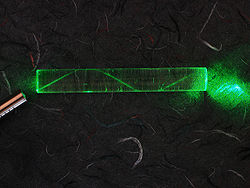 A laser beam bouncing down an acrylic rod, illustrating the total internal reflection of light in a multimode optical fiber
A laser beam bouncing down an acrylic rod, illustrating the total internal reflection of light in a multimode optical fiber
Optically transparent materials focus on the response of a material to incoming light waves of a range of wavelengths. Guided light wave transmission via frequency selective waveguides involves the emerging field of fiber optics and the ability of certain glassy compositions as a transmission medium for a range of frequencies simultaneously (multi-mode optical fiber) with little or no interference between competing wavelengths or frequencies. This resonant mode of energy and data transmission via electromagnetic (light) wave propagation is relatively lossless.
An optical fiber is a cylindrical dielectric waveguide that transmits light along its axis by the process of total internal reflection. The fiber consists of a core surrounded by a cladding layer. To confine the optical signal in the core, the refractive index of the core must be greater than that of the cladding. The refractive index is the parameter reflecting the speed of light in a material. (Refractive index is the ratio of the speed of light in a vacuum to the speed of light in a given medium. The refractive index of a vacuum is therefore 1). The larger the refractive index, the more slowly light travels in that medium. Typical values for core and cladding of an optical fiber are 1.48 and 1.46, respectively.
When light traveling in a dense medium hits a boundary at a steep angle, the light will be completely reflected. This effect, called total internal reflection, is used in optical fibers to confine light in the core. Light travels along the fiber bouncing back and forth off of the boundary. Because the light must strike the boundary with an angle greater than the critical angle, only light that enters the fiber within a certain range of angles will be propagated. This range of angles is called the acceptance cone of the fiber. The size of this acceptance cone is a function of the refractive index difference between the fiber's core and cladding. Optical waveguides are used as components in integrated optical circuits (e.g. combined with lasers or light-emitting diodes, LEDs) or as the transmission medium in local and long haul optical communication systems.
Mechanisms of attenuation
See also: Light scatteringAttenuation in fiber optics, also known as transmission loss, is the reduction in intensity of the light beam (or signal) with respect to distance traveled through a transmission medium. Attenuation coefficients in fiber optics usually use units of dB/km through the medium due to the very high quality of transparency of modern optical transmission media. The medium is usually a fiber of silica glass that confines the incident light beam to the inside. Attenuation is an important factor limiting the transmission of a signal across large distances. In optical fibers the main attenuation source is scattering from molecular level irregularities (Rayleigh scattering)[13] due to structural disorder and compositional fluctuations of the glass structure. This same phenomenon is seen as one of the limiting factors in the transparency of infrared missile domes[citation needed]. Further attenuation is caused by light absorbed by residual materials, such as metals or water ions, within the fiber core and inner cladding. Light leakage due to bending, splices, connectors, or other outside forces are other factors resulting in attenuation.[14][15]
See also
- Turbidity
- Brillouin scattering
- Colloidal crystal
- Light scattering
- Optical fiber
- Pellicle mirror
- Photonic crystal
- Transparent metals
- Transparent ceramics
References
- ^ Fox, M. (2002). Optical Properties of Solids. Oxford University Press.
- ^ Kerker, M. (1969). The Scattering of Light. Academic, New York.
- ^ Mandelstam, L.I. (1926). "Light Scattering by Inhomogeneous Media". Zh. Russ. Fiz-Khim. Ova. 58: 381.
- ^ van de Hulst, H.C. (1981). Light scattering by small particles. New York: Dover. ISBN 0486642283.
- ^ Bohren, C.F. and Huffmann, D.R. (1983). Absorption and scattering of light by small particles. New York: Wiley.
- ^ Yamashita, I., et al. (2008). "Transparent Ceramics". J. Am. Ceram. Soc. 91 (3): 813. doi:10.1111/j.1551-2916.2007.02202.x.
- ^ Simmons, J. and Potter, K.S. (2000). Optical Materials. Academic Press.
- ^ Uhlmann, D.R., et al. (1991). Optical Properties of Glass. Amer. Ceram. Soc..
- ^ Gunzler, H. and Gremlich, H. (2002). IR Spectroscopy: An Introduction. Wiley.
- ^ Stuart, B. (2004). Infrared Spectroscopy: Fundamentals and Applications. Wiley.
- ^ Mott, N.F. and Jones, H.. Theory of the Properties of Metals and Alloys. Clarendon Press, Oxford (1936) Dover Publications (1958).
- ^ Griffin, A. (1968). "Brillouin Light Scattering from Crystals in the Hydrodynamic Region". Rev. Mod. Phys. 40 (1): 167. Bibcode 1968RvMP...40..167G. doi:10.1103/RevModPhys.40.167.
- ^ I. P. Kaminow, T. Li (2002), Optical fiber telecommunications IV, Vol.1, p. 223
- ^ Smith, R.G. (1972). "Optical power handling capacity of low loss optical fibers as determined by stimulated Raman and Brillouin scattering". Appl. Opt. 11 (11): 2489. Bibcode 1972ApOpt..11.2489S. doi:10.1364/AO.11.002489. PMID 20119362.
- ^ Archibald, P.S. and Bennett, H.E. (1978). "Scattering from infrared missile domes". Opt. Eng. 17: 647. Bibcode 1978SPIE..133...71A.
Further reading
- Electrodynamics of continuous media, Landau, L. D., Lifshits. E.M. and Pitaevskii, L.P., (Pergamon Press, Oxford, 1984)
- Laser Light Scattering: Basic Principles and Practice Chu, B., 2nd Edn. (Academic Press, New York 1992)
- Solid State Laser Engineering, W. Koechner (Springer-Verlag, New York, 1999)
- Introduction to Chemical Physics, J.C. Slater (McGraw-Hill, New York, 1939)
- Modern Theory of Solids, F. Seitz, (McGraw-Hill, New York, 1940)
- Modern Aspects of the Vitreous State, J.D.MacKenzie, Ed. (Butterworths, London, 1960)
External links
- Properties of Light
- UV-Vis Absorption
- Infrared Spectroscopy
- Brillouin Scattering
- Transparent Ceramics
- Bulletproof Glass
- Transparent ALON Armor
- Properties of Optical Materials
- What makes glass transparent ?
- Brillouin scattering in optical fiber
- Thermal IR Radiation and Missile Guidance
Glass science topics Basics Glass formulation - AgInSbTe
- Bioglass
- Borophosphosilicate glass
- Borosilicate glass
- Ceramic glaze
- Chalcogenide glass
- Cobalt glass
- Cranberry glass
- Crown glass
- Flint glass
- Fluorosilicate glass
- Fused quartz
- GeSbTe
- Gold ruby glass
- Lead glass
- Milk glass
- Phosphosilicate glass
- Photochromic lens glass
- Silicate glass
- Soda-lime glass
- Sodium hexametaphosphate
- Soluble glass
- Tellurite glass
- Ultra low expansion glass
- Uranium glass
- Vitreous enamel
- Wood's glass
- ZBLAN
Glass-ceramics Glass preparation Optics - Achromat
- Dispersion
- Gradient index optics
- Hydrogen darkening
- Optical amplifier
- Optical fiber
- Optical lens design
- Photochromic lens
- Photosensitive glass
- Refraction
- Transparent materials
Surface modification Diverse topics Categories:- Optical materials
- Glass engineering and science
- Transparent materials
Wikimedia Foundation. 2010.

